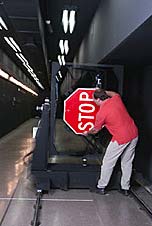New NIST Facility Soon Will Be ‘Reflecting’ on Safer Signs

© R. Rathe
Our roadways should get safer in the future, now that the National Institute of Standards and Technology (NIST) has developed a way to accurately and reliably measure how light reflects off stop signs and other road markings.
Road signs and markings are designed to be visible at night by retroreflectivity—that is, they reflect some of the light emitted by a vehicle’s headlights back toward the driver’s eyes. However, measurements of retroreflectivity have varied so much among different devices and laboratories that federal transportation officials have been unable to define minimum standards for this Congressionally mandated characteristic.
Recently, NIST established a facility—funded by the Transportation Research Board of the National Cooperative Research Program—that resolves numerous measurement problems and improves accuracy. Inside the facility, one finds a long black tunnel with a set of tracks on which sits an instrumented platform. Signs or materials are mounted on the platform, which can be moved 3 to 30 meters (10 to 100 feet) from a light source at one end of the tunnel. Using custom software, scientists precisely control all of the components and measure the characteristics of light reflected from the sign to a detector located close to the source.
NIST expects that the facility will begin providing calibration services early in 2004.
Media Contact
More Information:
http://www.nist.gov/public_affairs/techbeat/tb2003_0811.htm#signsAll latest news from the category: Transportation and Logistics
This field deals with all spatial and time-related activities involved in bridging the gap between goods and people, including their restructuring. This begins with the supplier and follows each stage of the operational value chain to product delivery and concludes with product disposal and recycling.
innovations-report provides informative reports and articles on such topics as traffic telematics, toll collection, traffic management systems, route planning, high-speed rail (Transrapid), traffic infrastructures, air safety, transport technologies, transport logistics, production logistics and mobility.
Newest articles

Properties of new materials for microchips
… can now be measured well. Reseachers of Delft University of Technology demonstrated measuring performance properties of ultrathin silicon membranes. Making ever smaller and more powerful chips requires new ultrathin…

Floating solar’s potential
… to support sustainable development by addressing climate, water, and energy goals holistically. A new study published this week in Nature Energy raises the potential for floating solar photovoltaics (FPV)…

Skyrmions move at record speeds
… a step towards the computing of the future. An international research team led by scientists from the CNRS1 has discovered that the magnetic nanobubbles2 known as skyrmions can be…





















